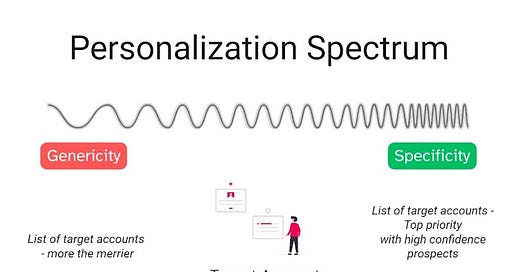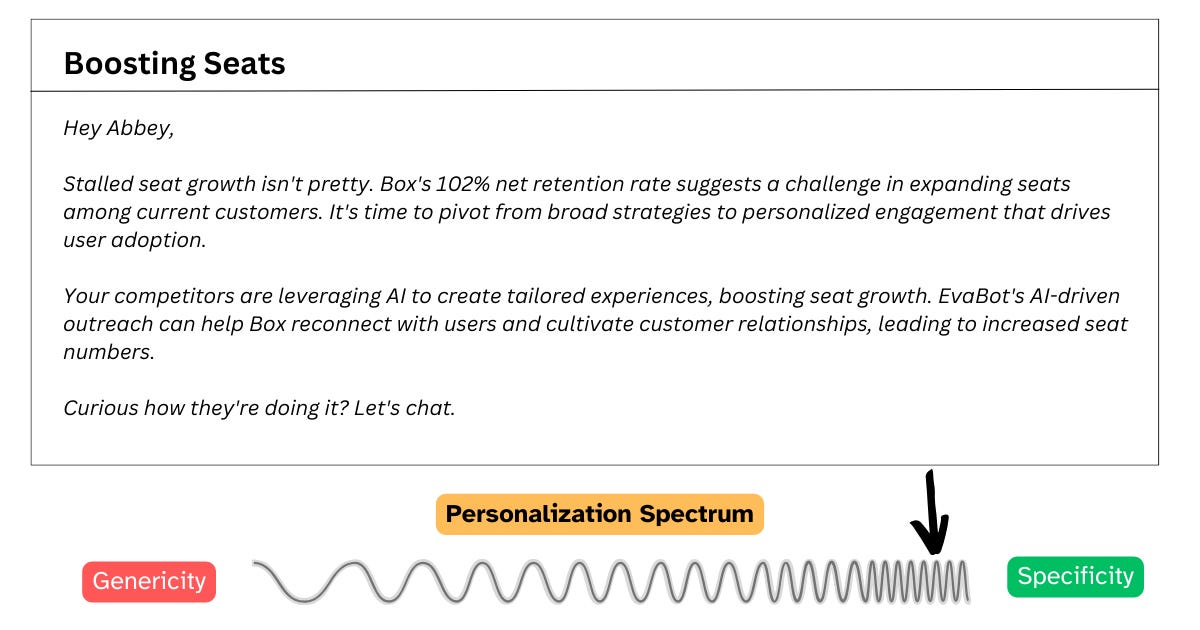Your personalization workflows: Analyze and Improve
Boost your response rates by evaluating and enhancing your personalization strategies. Learn how to move from generic to specific personalization by evaluating and adopt AI tools.
Hey, Welcome to this week’s edition of “Future of Prospecting” Newsletter by “Evabot”.
We have been researching Generative AI Technology for the last 18 months and have been astounded by the use cases it brings in Prospecting through Hyper Targeting and Personalization. For Sales leaders and Revenue leaders, the main challenge with AI-led Prospecting is “How and What not?”
We have recently launched our whitepaper on “How to evaluate a Sales AI Tool?”. Check it out…
Subscribe to get access to our weekly posts on Prospecting, Automation, AI, Revenue Growth and Lead Generation.
Do you wonder why most of your outreach emails get ignored while less than 0.7% got the “Reply”?
It's all about personalization.
Here are a few of the statements from senior sales leaders…
1. People buy from people.
2. Brains are tuned to ignore verbose messages.
3. High-ticket sales were and will always be human-led.
4. Buyers know that they are being targeted through automation.
5. Buyers feel that they are being sold to rather than being helped.
Now the question is -
Personalization to what extent?
Generic or Specific?
We already have covered a bit about Generic vs Specific Personalization on this link.
In this newsletter, we are going to discuss how you can evaluate your personalization techniques and craft a personalization message with higher specificity.
Audit your communication for personalization effectiveness
The Two Ends of Personalization Spectrum
Evaluate your message for Personalization Spectrum
Key Differences - Generic vs Specific Personalization
Framework to evaluate your message on Personalization Spectrum
Audit your communication for personalization effectiveness
If you are hyper-personalizing your prospecting communication through a Sales AI Tool, here are 5 questions to audit your current outreach messaging and expected outreach messaging on “Personalization Spectrum”…
"Does your prospecting message merely intermix value propositions, or does it include researched facts across more than 50 specific business and personal parameters?"
"In the past 12 months, have your response rates increased, decreased, or remained the same?"
"Is your outreach message generating higher response rates, higher open rates, or both?"
"Does your outreach process focus on 'Who', 'What', 'When', and 'How'? Is it one of these, a few, or all of them?"
"What does leadership emphasize in monthly targets – 'Let's get a few responses' or 'Let's aim to capture attention and build relationships'?"
The Two Ends of Personalization Spectrum
The two ways messages are personalized today: Generic vs. Specific.
Generic Personalization:
It involves bulk AI-generated messages. Uses basic data points like:
- Their name
- Job change info
- College sports info
- Acquisition news
- Your value proposition
While these emails include some personal details, they often lack depth and emotional connection.
Are you following “Generic Personalization”?
Specific Personalization:
- Requires more effort but yields better results.
- Feels like a handwritten letter tailored to the recipient's unique situation.
Key Elements for Specific Personalization:
- It addresses their current pains.
- It connects with them personally by mentioning background and achievements.
- It uses language that resonates with them personally.
- It focuses on how you can help them specifically, not just your sales pitch.
Generic emails often feel impersonal and "salesy." They lack emotional connection and may come across as just another marketing message. On the other hand, specific personalization speaks directly to the recipient’s pain points, emotions, and needs.
What actually is important to draft “Specific Personalization” communications:
Relevant and Recent Insights
Ensure you have a list of current issues they are discussing or experiencing now—things they've recently mentioned in meetings or online posts.
By understanding these two approaches—generic versus specific—you can pinpoint what's missing in your current personalization workflow and make adjustments accordingly.
Evaluate your message
Let's understand the nitty-gritty of identifying whether your email is generically personalized or specifically personalized.
This evaluation can make a huge difference in your response rates.
Key parameters to check in your communication:
Relevant Insights: Does the email contain information that is pertinent to the recipient's current situation?
Recent Insights: Are you using up-to-date data or insights that require immediate attention?
Pain Points: Have you addressed specific challenges they are currently facing based on these insights?
Emotional Triggers: Did you include personal touches like references to their college sports team, mascot, or other achievements?
Value Proposition Alignment: Is your value proposition clearly aligned with their pain points and needs? Have you highlighted how you can solve their unique pain points effectively?
Actionable Steps:
1. Review emails sent by the sales team over the last 30 days.
2. Evaluate each email on its personalization scale:
- Does it meet our criteria for specific personalization?
- Where does it fall short?
Decide which one of the following “specific personalization” process would you like to adopt while retaining a personal touch:
Manual Process: Pulling insights and creating emails manually before sending them.
Semi-Automated Process: Pulling insights, setting preferences, suggesting templates, one-click email creation with options for manual improvements and suggestions.
Fully Automated AI Process: Letting AI handle everything from gathering insights to creating and sending emails.
By following the above steps and asking above questions, you'll be better equipped to distinguish between generic and specific personalization in your outreach efforts and plan the next steps.
Key Differences - Generic vs Specific Personalization
As a sales professional and leader, it's critical for you to understand the key differences between generic and specific personalization across the outreach workflow.
Target Accounts
Research & Insights
Hallucination check
Selecting Relevant Insights
Personalized Message Draft
Redundancy check
Send Message
Monitor & Adjust
By grasping these key differences in approach (as in the infographic below), you can transition your strategy from generic mass emails to highly specific personalized messages that ticks more profoundly with prospects.
Evaluating an AI tool for Specific Personalization?
To identify and evaluate an AI tool that can help you draft specific personalized messages at scale, rate the following:
What are the types of signals that a tool can personalize?
Pre-Intent Signals (pain signals from 10K reports, Quarterly filing reports) + Personal background (Hobby, College Sports, Community, Achievements) + Transactional Signals (Job Change, Announcements, G2 Signals)
Personal background (Hobby, College Sports, Community, Achievements) + Transactional Signals (Job Change, Announcements, G2 Signals)
Transactional Signals (Job Change, Announcements, G2 Signals)
No signals, only USP
Can you use expert messaging frameworks (like OPPS, PSA)?
Yes
No
Are the generated personalized messages mentioning recent pains?
Yes
No
Is the message same or unique for each customer in one type of industry?
Unique
Same
Here’s a step-by-step breakdown for this scoring system:
Types of Signals for Hyper-Personalization:
Pre-Intent Signals + Personal background + Transactional Signals: Score = 4
Personal background + Transactional Signals: Score = 3
Transactional Signals only: Score = 2
No signals, only USP: Score = 1
Expert Messaging Frameworks (like OPPS, PSA):
Yes: Score = 1
No: Score = 0
Pain-based Personalization (Pains mentioned in generated messages):
Yes: Score = 1
No: Score = 0
Uniqueness of Messages:
Unique for each customer: Score = 1
Same for all customers in one industry: Score = 0
Calculate the total score by adding the scores for each category. Each category contributes directly to the final score.
Formula:
Total Score = Signals Score + Expert Messaging Score + Pain Personalization Score + Uniqueness Score
Determine the range for each classification based on the total score, which has a maximum possible score of 7 (4 from Signals + 1 from Messaging + 1 from Pain Personalization + 1 from Uniqueness):
6-7: Winner
3-5: Moderate Choice
0-2: Loser
Examples of Scoring:
Tool A: Uses all signals types (Score = 4), uses expert messaging (Score = 1), messages are pain-based (Score = 1), messages are unique (Score = 1)
Total Score = 4 + 1 + 1 + 1 = 7
Classification: Winner
Example - Evabot
Tool B: Uses Personal background + Transactional Signals (Score = 3), does not use expert messaging (Score = 0), messages are not pain-based (Score = 0), messages are unique (Score = 1)
Total Score = 3 + 0 + 0 + 1 = 4
Classification: Moderate Choice
Tool C: Only uses Transactional Signals (Score = 2), does not use expert messaging (Score = 0), messages are not pain-based (Score = 0), messages are the same for the industry (Score = 0)
Total Score = 2 + 0 + 0 + 0 = 2
Classification: Loser
This scorecard allows for a clear and objective assessment of each tool's capability in delivering a personalized communication, making it easier to identify the best tools for specific needs.
By understanding the key differences between generic and specific personalization, you can elevate your outreach strategy to create messages that truly resonate with your prospects.
Evaluate your current methods, automate wisely, and focus on making each interaction meaningful.
Want to check how to transform your approach from generic to specific personalization? Book a demo on the link below…









